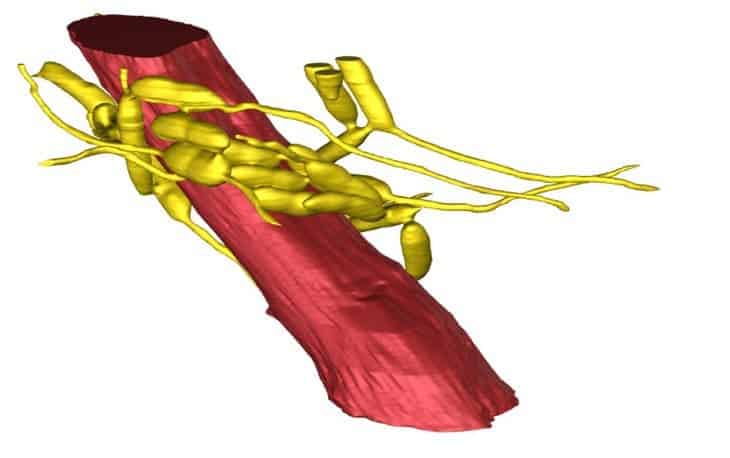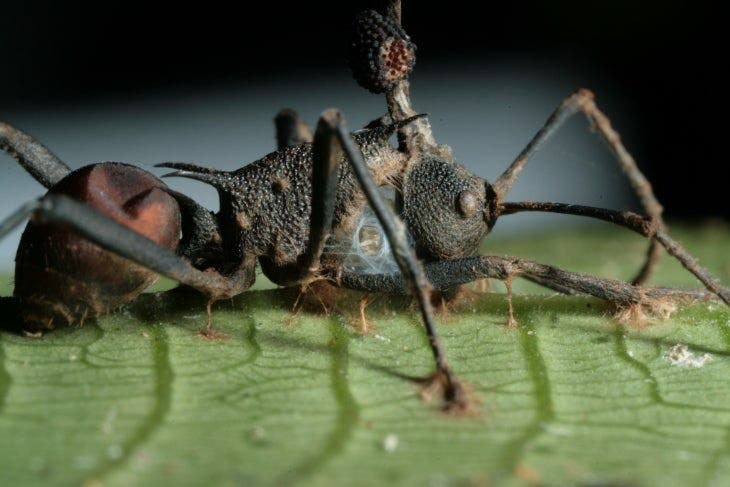Nature can get disturbingly bizarre and scary. One of the most ghastly animal behaviors we know of is that of the ‘zombie ant fungus’ which takes control of living ants in order to spread its spores to other individuals. Scientists have studied by this disturbing strategy for more than a hundred years, and they’re still learning more about it. A new study found that the fungus is actually even sneakier than previously thought. Penn State researchers report that the parasite controls its hosts without actually infecting the brain. Instead, like a masterful puppeteer, the fungus takes control of the ant’s limbs, forcing the host to act against its own will. That’s just a whole new level of wickedness.
The weird parasite, known as Ophiocordyceps unilateralis sensu lato, was first discovered by the British naturalist Alfred Russel Wallace in 1859, and is currently found predominantly in the tropical forests of Thailand but also Brazil’s rainforests. Once it infects a carpenter or worker ant, the parasite forces its host’s muscles to grab a leaf (or something else) when, where, and how the fungus wants it. They also force the ant to wander around in a drunken haze until it clamps its jaws on the underside of a leaf in what can only be called an ant zombie graveyard. The dead ant has now become food, helping the fungus to grow into a stalk out of the host’s head, which releases spores in the ground below where it should infect other ants. The cycle repeats and the fungus profits.
Previously, research showed that while holding on to the leaf with the death grip, the heads of diseased ants are filled with fungal cells and the muscles which operate the ant’s jaw are atrophied. Mandibles that normally open and close have now become unidirectional — they can only close. This keeps the ant from loosening its grip or dropping the leaf. Another thing the fungus does is suck all the calcium from the ant’s muscles, causing a condition similar to rigor mortis.
Penn State researchers have uncovered something different, though, after they painstakingly studied the corpses of infected ants in unprecedented detail. The scientists first infected ants with either the dreaded mind-control fungus or some other benign fungus in order to assess the cellular interactions unique to Ophiocordyceps u.
“The fungus is known to secrete tissue-specific metabolites and cause changes in host gene expression as well as atrophy in the mandible muscles of its ant host. The altered host behavior is an extended phenotype of the microbial parasite’s genes being expressed through the body of its host. But it’s unknown how the fungus coordinates these effects to manipulate the host’s behavior,” said Penn State’s Maridel Fredericksen, lead author of the study.
Each infected ant was cut into numerous 50-nanometer slices of tissue which were imaged with scanning electron microscopy, then stacked to create a high-res 3-D image. A sophisticated machine learning algorithm then analyzed the slices to quickly and accurately identified fungal cells among ant cells.

3D image of an ant mandible adductor muscle (red) surrounded by parasitic fungal cells (yellow). Credit: Hughes Laboratory/Penn State.
Surprisingly, the analysis showed that while the fungal cells were spread throughout the ant’s body (head, thorax, abdomen, and legs), these were absent from the brain. However, fungal cells did cluster around the outskirts of the brain with which it interacted chemically, as reported in the Proceedings of the National Academy of Sciences.
“Normally in animals, behavior is controlled by the brain sending signals to the muscles, but our results suggest that the parasite is controlling host behavior peripherally,” says David Hughes, senior author of the study. “Almost like a puppeteer pulls the strings to make a marionette move, the fungus controls the ant’s muscles to manipulate the host’s legs and mandibles.”
This way, the researchers say, the fungus can take control of the ant while still keeping it alive — or at least until it’s served its purpose.
“We hypothesize that the fungus may be preserving the brain so the host can survive until it performs its final biting behavior – that critical moment for fungal reproduction,” says Hughes. “But we need to conduct additional research to determine the brain’s role and how much control the fungus exercises over it.”










